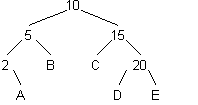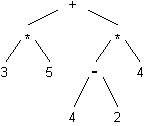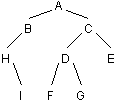
A. 10 5 2 A B 1 5 C 20 D E
B. 10 5 15 2 B C 20 A D E
C. 2 A 5 B 10 C 15 D 20 E
D. A 2 B 5 C D E 20 15 10
E. A 2 B 5 10 15 C 20 D E
Use the trees below to answer questions 6 and 7.

A. 1
B. 4
C. 8
D. 9
E. 16
|
A. 23 B. 34 C. 90 D. 120 E. 232 |
 |
A. They will always have the same number of ancestors.
B. In a binary tree a given node can have two siblings.
C. They will always have the same parent.
D. They will always be on the same level in the tree.
Questions 11 - 13 are base on the following pseudocode for a function P that copies items from an array A containing N distinct items into a binary search tree T and then prints the items. Function P
- Step 1: Initialize binary search tree T to be empty.
- Step 2: For i = 0 to N-1, use the standard algorithm for insertion into a binary search tree to insert item a[i] into T.
- Step 3: Print the items stored in T, using an inorder traversal. Assume that the insert operation used in Step 2 does no balancing of T.
A. The items are printed in the same order in which they appear in array A.
B. The items are printed in sorted order.
C. The items are printed in random order.
D. the items are printed in reverse of the order in which they appear in array A.
E. The value stored in A[1] is printed N times.
A. O ( 1 )
B. O ( log N )
C. O ( N )
D. D. O ( N log N )
E. E. O ( N2 )
- i. Ascending order
- ii. Descending order
- iii. Alternating positive and negative numbers
B. ii only
C. iii only
D. i and ii only
E. i, ii, and iii
A. Use the new function to create the new node, fill the data fields of the new node, set its point fields to
NULL, and insert the new node at the root.B. Use the new function to create the new node, fill the data fields of the new node, set its pointer fields to
NULL, locate the correct location for the node to be added as a leaf, and change the parent's pointer so that it points to the new node.C. Use the new function to create the new node, fill the data fields of the new node, determine the correct location of the new node and set its pointer field to point to its parent node.
D. Use the new function to create the new node, fill the data fields of the new node, set its right pointer to point to its parent node and its left pointer to
NULL.
A. the tree only has one node
B. the node is a leaf
C. the node has a single subtree
D. the node has two subtrees
Current points to the node being deleted and Parent points to the parent of that node.
if (parent.getRight() == current)
parent.setRight(NULL);
else parent.getLeft() = NULL;if (current == current.getRight())
parent.setRight(NULL);
else parent.setLeft(NULL);if (! current.getRight() )
parent.setRight(NULL);
else parent.setLeft(NULL);if ( parent == current)
parent.setValue(NULL);
Consider the declaration below.
int m (int i, int j)
{
if (i >= j)
return i;
else return j;
}
int f (TreeNode t)
{
if ( t.getLeft() == NULL && t.getRight() == NULL)
return t.getValue();
if (t.getLeft() == NULL)
return m (t.getValue(), f(t.getRight()));
if (t.getRight() == NULL)
return m(t.getValue(), f( t.getLeft()));
return m ( m ( t.getValue(), f ( t.getLeft())), f (t.getRight()));
}
f,
t != NULL, then f evaluates to which of the following?
- The greatest
Valuein the tree - The least
Valuein the tree - The
Valueat the root of the tree - The
Valueat the last node of the tree that was visited during the execution off - The first duplicated
Valueencountered during the execution off
|  |
- A nonordered tree can be empty whereas an ordered tree must have at least one node.
- In a nonordered tree the relative positions of the subtrees are significant whereas in an ordered tree they are not significant.
- In an ordered tree the relative positions of the subtrees are significant whereas in a nonordered tree they are not significant.
- An ordered tree has a root node whereas a nonordered tree does not.
Suppose a binary tree is defined as follows.
Consider the following function
int D (TreeNode t)
{
if ( t.getValue() == NULL)
return 0;
return 1 + Max(Height(t.getLeft()) +
Height(t.getRight()),D(t.getLeft()),D(t.getRight()))
}
Max returns the largest of its three integer arguments, and function Height returns the height of its tree argument, where height of a tree is defined as follows.
- The height of an empty tree is 0.
- The height of a nonempty tree is the number of nodes on the longest path from the root to a leaf of the tree.
What value is returned when D is passed an argument representing the following tree of height 5?
|  |
Consider the following tree and traversals.
|  |
- D E M O C R A T S
- R E P U B L I C A N S
Use the following TYPE declaration for questions 25 and 26.
int Treesum (TreeNode P)
{
int temp = 0;
if ( P.getValue()!=NULL )
temp = Treesum(P.getLeft()) +
Treesum(P.getRight()) + P.getValue();
return temp;
}
- only empty trees
- only non-empty trees
- all trees
- no trees
int Treesum (TreeNode P)
{
if ( P.getValue()!=NULL )
{
int temp = 0;
temp = Treesum(P.getLeft()) +
Treesum(P.getRight()) + P.getValue();
}
return temp;
}
- only empty trees
- only non-empty trees
- all trees
- no trees
Completion
a + b * c + d e
- column 1: row index of left child
- column 2: info
- column 3: row index of right child
A row index of 0 indicates no child.
Sketch the tree represented by this matrix.
| 0 | 4 | 0 |
| 0 | 3 | 3 |
| 0 | 5 | 0 |
| 2 | 7 | 1 |